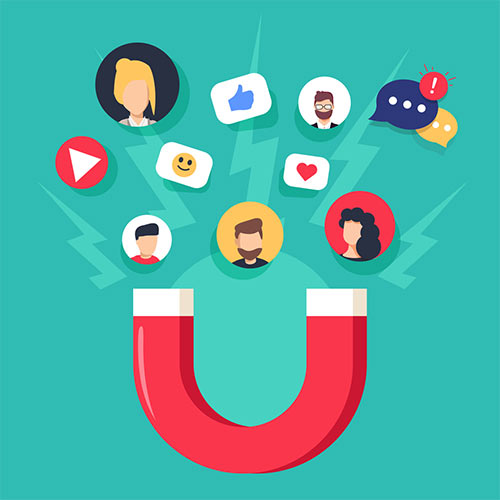
Inbound Marketing
Attract > Convert > Close > Delight.
Every small business owner dreams of sustainable growth. But how do you turn occasional visitors into devoted customers? The answer lies in an effective Inbound Marketing strategy. At its core, Inbound Marketing focuses on four primary stages: Attract, Convert, Close, and Delight. Let’s start turning strangers into loyal customers, for your small business today!

Our Inbound Marketing Strategy…
In this digital age, small business owners need a strategy tailored to their unique needs. Inbound Marketing, with its focus on creating lasting customer relationships, is that strategy. Reach out to us today to begin your journey.
1. Attract. Targeting the correct audience
For any marketing strategy to be effective, it first needs to target the correct audience. In the Attract phase, we utilize various techniques to bring potential customers to your digital doorstep.
- Content Creation: Crafting high-quality, relevant content that resonates with your target audience. This could be blog posts, infographics, or informative videos.
- Search Engine Optimization (SEO): Ensuring your business ranks high on search engines, making it easier for potential clients to find you.
- Social Media Marketing: Engaging your audience where they spend most of their time – on platforms like Facebook, Instagram, X (formerly known as Twitter), and TikTok.
2. Convert. Transforming visitors into leads
Once you’ve caught the attention of your visitors, the next step is crucial: conversion. Here’s how we make it happen:
- Landing Pages: Designing compelling pages that prompt action.
- Calls-to-Action (CTA): Encouraging visitors to take the next step, whether that’s signing up for a newsletter or downloading a free ebook.
- Forms: Capturing essential lead information so you can continue to engage with them.
3. Close. Sealing the deal
The ultimate aim of any business owner is sales. In the close phase, we nurture leads to ensure they turn into paying customers.
- Email Campaigns: Keeping leads engaged through tailored emails, sharing the latest offers, and providing value.
- CRM Systems: Keeping track of every interaction to provide a personalized experience. [Link to our CRM solutions page]
- Lead Scoring: Identifying which leads are ready to buy and which need more nurturing.
4. Delight. Keep them coming back
After securing a sale, the relationship shouldn’t end. Delighting customers ensures they become brand advocates, referring others and returning for more.
- Feedback Surveys: Listening to what customers have to say and continuously improving.
- Loyalty Programs: Rewarding customers for their continued trust and business.
- Community Building: Engaging with customers on social media, forums, and other platforms to foster a sense of community.
Inbound Marketing to help your business thrive
If you’re ready to pivot to a more audience-centric approach, foster genuine relationships, and build a
loyal customer base, then it’s time to dive deep into the world of inbound marketing.
Take the leap and transform your marketing approach. Get started with inbound today. Your audience
is out there, searching, engaging, and ready to connect. Be the answer they’re looking for.
Frequently Asked Questions…
Q: What is Inbound Marketing?
A: Inbound Marketing is a strategy that focuses on attracting, converting, closing, and delighting customers by providing value at every step of their journey.
Q: Does inbound marketing really help small businesses?
A: Yes! It’s cost-effective, which is very important for small business owners where every penny counts, and it targets potential customers in a personalized and engaging manner, building lasting relationships.
Q: How does content play a role in Inbound Marketing?
A: Quality content attracts the right audience, establishes authority, and provides value, making it a cornerstone of the strategy.
Q: How do you measure the success of an Inbound Marketing campaign?
A: Through various metrics such as website traffic, lead conversion rates, and customer feedback.
Q: What’s the difference between Inbound and Outbound Marketing?
A: While Inbound Marketing focuses on organically attracting customers by providing value, Outbound marketing involves using less efficient big-net solutions such as postcard mailers, billboards, radio/TV ads, cold calling, and email blasts that typically land you marked as spam.
Q: How long before I see results from Inbound Marketing?
A: While some results can be seen quickly, Inbound Marketing is a long-term strategy, and the most significant returns often appear over extended periods.